Export Financials Overview
The SapphireOne Export Financials Report provide an overview of your financial results allowing for a clear understanding of your business.
The Export Financials report in SapphireOne functions similarly to the Standard Financials report, with the key difference being its interaction with the default printer option from the Print Destination menu. When you use the default Printer option from the Print Destination menu and click the  Print button, SapphireOne will automatically generate a CSV file. This CSV file will then open using the default spreadsheet application on your local machine. Please note that there is no option to send this report directly to a printer. To retain a copy of the CSV file produced by SapphireOne, it is recommended that you choose the Save option from the spreadsheet application.
Print button, SapphireOne will automatically generate a CSV file. This CSV file will then open using the default spreadsheet application on your local machine. Please note that there is no option to send this report directly to a printer. To retain a copy of the CSV file produced by SapphireOne, it is recommended that you choose the Save option from the spreadsheet application.
Export Financials Reports
These reports allow you to export the balances associated with General Ledger Accounts, and you can customise the criteria for export. Within the Export Financials Report, there are three Standard Financial reports available. These reports facilitate the export of General Ledger Account balances based on various criteria, as outlined below:
- Trial Balance – A trial Balance is a list of all General Ledger accounts including the balance of their respective nominal Ledger accounts.
- Income Statement – The Income or Profit and Loss Statement offers a snapshot of your organisation’s operating results. It encompasses the income, expenditure, revenue, and expenses generated during a specific reporting period.
- Balance Sheet – The Balance Sheet furnishes insights into your organisation’s liquidity and capital structure by showcasing the assets, liabilities, and equity at a particular reporting date.
Choose the report that best suits your needs to export the relevant financial data.
Dictation and Speech to Text Overview
SapphireOne’s Dictation (MacOS) and Speech to Text (Windows) functionalities revolutionise data entry. These features are available for any data entry field and all inquiry screens within SapphireOne. For instance, when a user makes a call via the SapphireOne Softphone, SapphireOne automatically timestamps the contact and phone number. Post-call, users can dictate notes directly into the CRM contact memo field in relation to the stamp.
This functionality is applicable across all Data Entry screens. As examples, when entering a Vendor Invoice (VI), users can dictate memos directly. Similarly, additional lines can be added to the General Ledger account, with each line having a unique memo field. After an employee interview, users can efficiently dictate notes.
Speech to Text and Dictation are powerful tools that SapphireOne and its clients use daily, significantly saving time.
Options Button Usage
Furthermore, there is an  Options button that can be selected. When chosen, SapphireOne displays an additional Select Report Control screen, granting the user the ability to add extra criteria to the report. Details of this functionality is provided later in this article.
Options button that can be selected. When chosen, SapphireOne displays an additional Select Report Control screen, granting the user the ability to add extra criteria to the report. Details of this functionality is provided later in this article.
Export Financials Report Data Entry
Selecting the Export Financials option from the General Ledger menu will open a General Ledger Reports print dialog, as depicted below. From the initial dialog screen the user has a number of drop down menus to configure a report for exporting. These drop down menus are: Print Destination, Report Type, Report Details and Report Selection.
Print Destination Menu (Export Financials)
When you choose the Export Financials report, users will be presented with two options within the Print Destination menu, as explained below:
Please note that when using this Export Financials function, selecting either of the two options below will instruct your operating platform to generate a CSV file and launch the default spreadsheet program within your operating system.
- Printer – Opting for the Printer choice within the Print Destination menu and subsequently clicking the
 Print button, will trigger SapphireOne to generate a CSV file. Subsequently, it will initiate the default spreadsheet program installed on the local machine, such as Excel, to display the exported data. It is important to note that until this file is saved using the spreadsheet program, it remains unsaved to the hard drive.
Print button, will trigger SapphireOne to generate a CSV file. Subsequently, it will initiate the default spreadsheet program installed on the local machine, such as Excel, to display the exported data. It is important to note that until this file is saved using the spreadsheet program, it remains unsaved to the hard drive. - Custom Report –Alternatively, selecting the Custom Report option, prompts SapphireOne to immediately request the location of an existing Custom Report to be used as a template when the
 print button is activated. SapphireOne then generates the report, incorporating the chosen Custom Report as its template.
print button is activated. SapphireOne then generates the report, incorporating the chosen Custom Report as its template.
Report Types Menu (Export Financials)
Within the Export Financial reports there are three items for the user to select from. These reports allow the user to view the balances associated with a General Ledger Account using different criteria.
- Trial Balance Statement – A trial Balance statement is a list of all General Ledger accounts including the balance of their respective nominal Ledger accounts.
- Income Statement – The Income or Profit and Loss Statement presents the operating results of your organisation. It includes the income, expenditure, revenue and expenses generated during a reporting period.
- Balance Sheet – The balance sheet provides information about the liquidity and capitalisation of your organisation utilising the assets, liabilities, and equity at a particular reporting date.
Report Details Menu (Excport Financials)
These report options listed below provide the ability to produce summarised snapshots of your data. The user should be aware that a number of these reports are based on selections made from the Details Page and the More Details Page of your General Ledger Accounts.
| No Sort: | No sorted performed, the report is printed as it is in the list on screen. |
| Use Account ID: | Sorted and totaled by each General Ledger Account ID. |
| Use Account Name: | Sorted and Totaled by each General Ledger Account Name. |
| Use Account: | Sorted by Account number. |
| Use UDF ID: | Sorted and Totaled by UDF ID. |
| Use UDF: | Sorted by UDF Name. |
| Use Alternate ID: | Sort and total by Alternate ID. |
| Use Account ID by Custom Class: | Sort by Account ID then total or group by Custom Class. |
| Use Account Name by Custom Class: | Sort by Account Name then total or group by Custom Class. |
| Use Account by Custom Class: | Sort by Account and then Custom Class. |
| Use UDF ID by Custom Class: | Sort by UDF ID then total or group by Custom Class. |
| Use UDF by Custom Class: | Sort by UDF the total or group by Custom Class. |
| Use Alternate ID by Custom Class: | Sort by Alternate ID then total or group by Custom Class. |
| Use Class: | Sort then Total or group by Class. |
| Use Custom Class: | Sort then Total by Custom Class. |
| Use Department Class A: | Sort then Total or group by Class A. |
| Use Department Class B: | Sort then Total or group by Class B. |
| Use Department Class C: | Sort then Total or group by Class C. |
| Use Class by Custom Class: | Sort by Class the total or group by Custom Class. |
| Use Custom Class by Class: | Sort by Custom Class then total or group by Class. |
Report Selection Menu (Export Financials)
This menu gives you the following options: Standard Selection, Include Nil Balances, Include Inactive without Nil Balances and All Records.
Report Selection options
In SapphireOne, consistency in layout is maintained across all print dialogue screens, ensuring users do not need to constantly adapt to varying layouts. However, it’s important to note that the Report Selection options documented above, do differ for almost every print dialogue screen.
For additional filtering of reports using criteria from cells within related tables, refer to the following details. Once users enter data into either the third and fourth data entry fields below, the Selected Records radio button will become active, indicating that additional filtering is being applied to the report. A screenshot of this area is provided below for reference with the radio button active, (visible).

Directly beneath the Report Selection heading, you’ll find two rows, each containing four items, where you can establish additional selection criteria for your report. These rows consist of two drop-down menus and two data entry fields for user input.
In each row, the first drop-down menu allows users to select from various cells within related tables in the data file. These options in the first drop-down menu may or may not pertain to the same cells in the same table in the second row. To access the available options in these two drop-down menus, simply click on the respective item to display the drop-down menu and make your selections as required.
The second drop-down menu in both rows enables users to choose a mathematical option for each row. In this case, the available options are consistent and include: Equals, Not equal to, Less than, Greater than, Between, Contains, and Does not contain.
The last two columns in each row is where users input the data required for the mathematical calculations mentioned earlier. Typically, data is entered into the first data entry field. However, when selecting the Between option, data must be entered into both columns. This allows SapphireOne to filter the data based on the range defined by the user’s input in these two data entry fields.
Selecting Report Details of Use Class for both the Income Statement and Balance Sheet will enable you to view the format the reports will be generated in. Examples of these two reports follow in this article.
Buttons on the Reports dialog screen
- Print – From the Export Financials function there is no provision for sending the report to a printer. When the Print button is selected, SapphireOne will create and then display a CSV file.
- Cancel – This button cancels the current procedure.
- Record List – When this button is selected SapphireOne will allow the user to view the current selection.
- Options – When this button is selected SapphireOne will display an additional page where more options are able to be selected for the report. This is documented immediately below in this article.
- Queue – This button places the report on a queue to the printer.
- Background – This tell SapphireOne to print this job as a separate task in the background as time permits. It lowers the printing priority for the operating platform.
Report Examples (Export Financials)
This report was created using a Report Type of Income Statement and Report Details of Use Class.
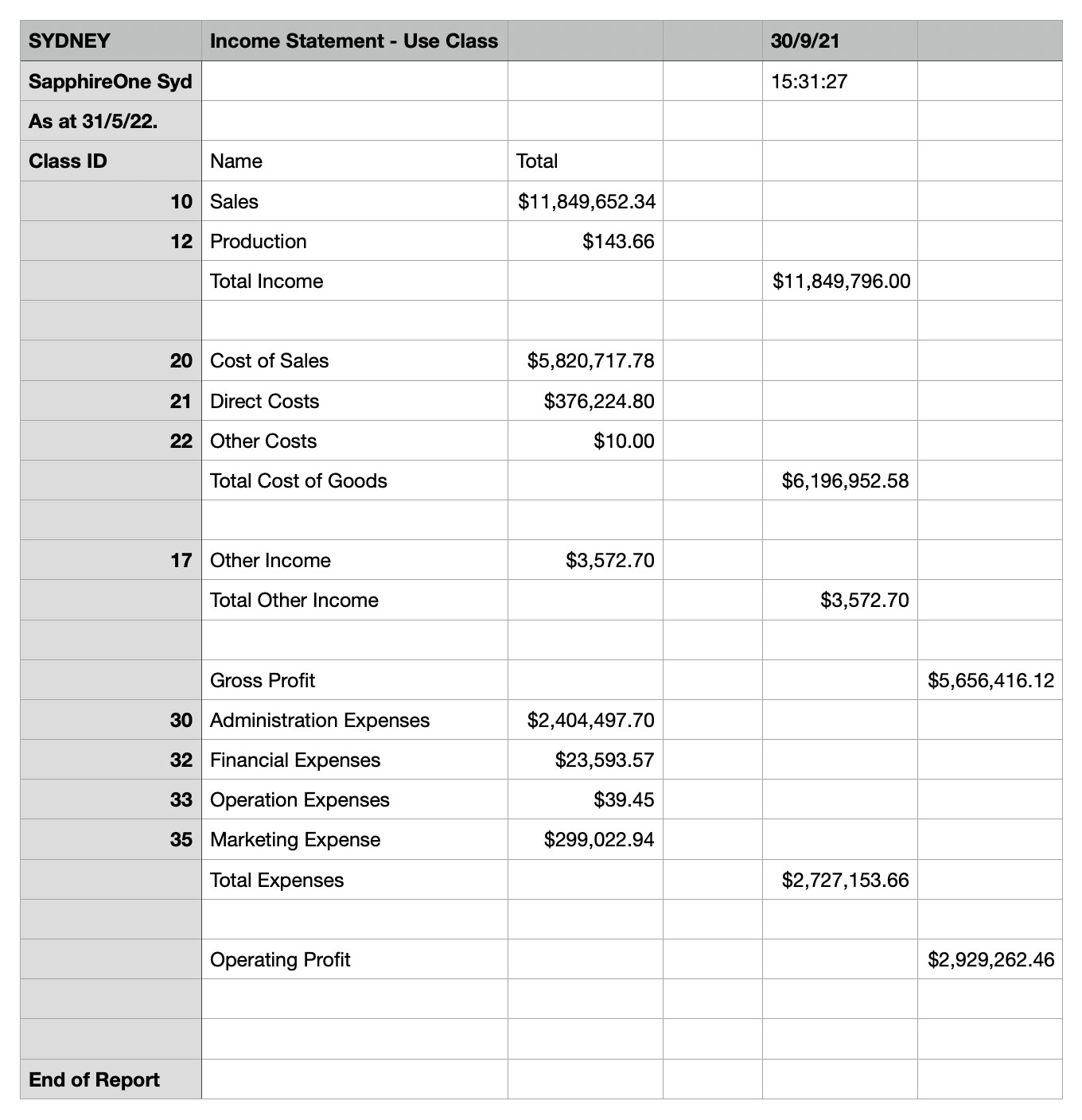
This report was created using a Report Type of Balance Sheet and Report Details of Use Class.
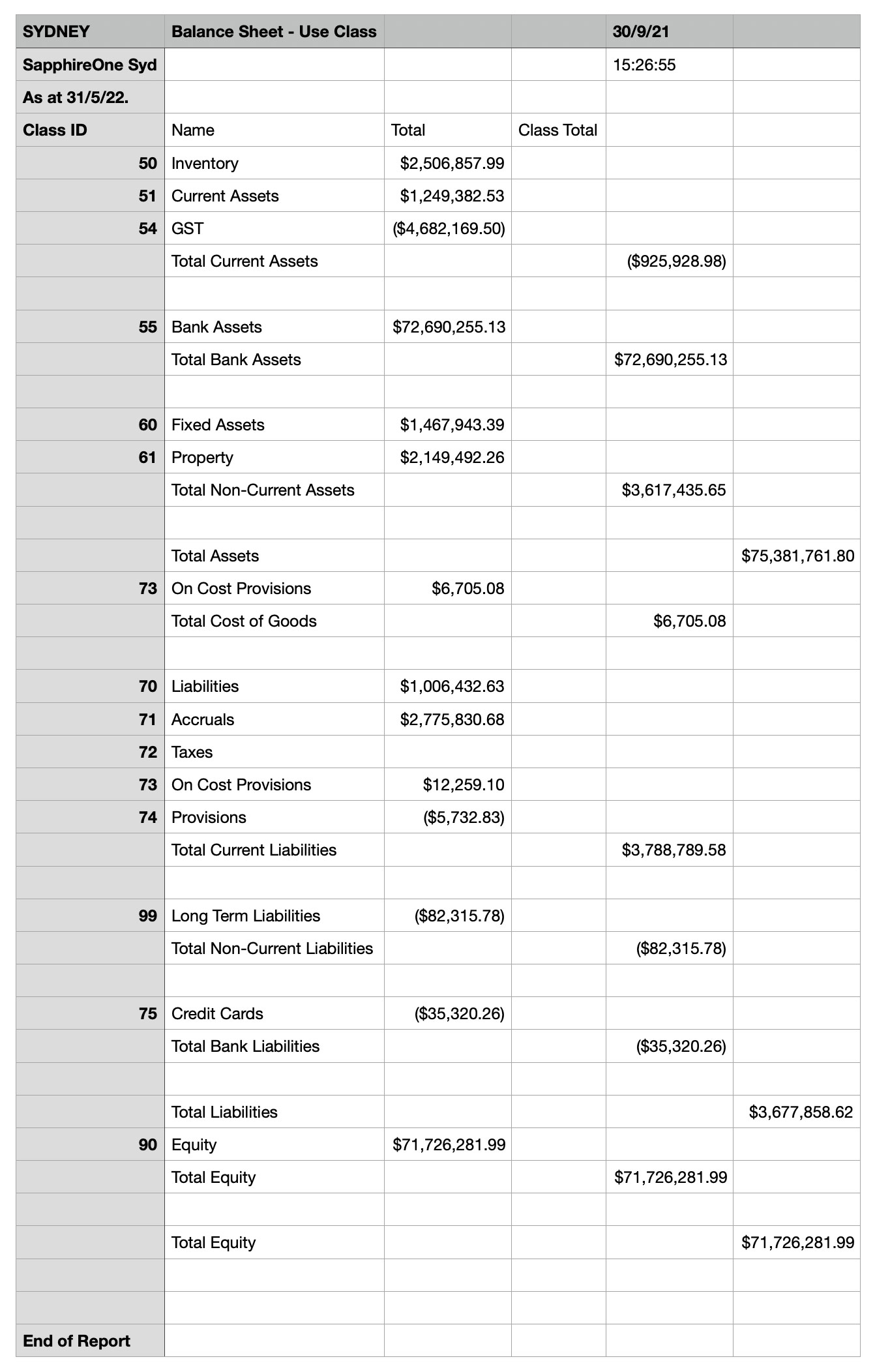
Options Button Usage (Export Financials)
Procedural note:
In the Options Menu for Standard Financials, it is crucial for the user to prioritise the selection of the Report Type and any other preferences within the print dialog, as documented previously. This should be done before proceeding to click on the ![]() Options button.
Options button.
Once the user has made their desired selections within the Options menu and is brought back to the General Ledger Reports dialog, their only permissible action is to immediately click the ![]() print button. Any attempt to select anything else within the General Ledger Reports dialog upon returning will promptly cancel any previously chosen options and configurations set up when the
print button. Any attempt to select anything else within the General Ledger Reports dialog upon returning will promptly cancel any previously chosen options and configurations set up when the ![]() Options button was selected.
Options button was selected.
Options Data Entry (Export Financials)
When the ![]() Options button is clicked, SapphireOne displays a Select Report Controls screen . It grants the user the ability to choose the reporting periods for both the Current Year or any of the previous 8 years. Additionally, users can opt to incorporate budget figures and customise the formatting and content of headings and sub-headings.
Options button is clicked, SapphireOne displays a Select Report Controls screen . It grants the user the ability to choose the reporting periods for both the Current Year or any of the previous 8 years. Additionally, users can opt to incorporate budget figures and customise the formatting and content of headings and sub-headings.
It’s essential to emphasize that users have the flexibility to utilise up to 12 columns when creating the reports, as illustrated in the screenshot provided above. The report will dynamically adjust its scale as needed to accommodate a single A4 page. Therefore, users should consider the content that will fit within the confines of an A4 page when designing their reports.
Saving Reports (Export Financials)
In the context of Export Financials, it’s vital to understand that SapphireOne does not automatically save a report when you use the ![]() Print button.
Print button.
However, within the Options menu, there is a data field labeled Saved Reports where users can execute the saving procedure themselves. It’s worth noting that when SapphireOne saves these reports, they are stored as part of the data file itself. Therefore, the sole method to retrieve these reports is to utilise the Export Financial function and follow these steps.
- Initial Navigation – Once the Export Financials print dialog is on screen, select the Options button and navigate directly to the Design area.
- Adding a Report – Select the Saved Reports menu. and once the list is visible, choose the Add… option.
- Report Name – Provide a name for your report and save it.
- Saved Report – Your saved report will be listed in the Saved Reports section, enabling you to retrieve it for future exports directly from within the data file.
- Deleting a Report – To delete a saved report, select it, then hold down the Command or Control key and click on it again. An alert will appear, requesting permission to delete the selected report. Please remember that this action cannot be undone.
- Spreadsheet Saving – Furthermore, users should be mindful that when the spreadsheet application is open on the screen, they can utilise the standard saving options available within the spreadsheet application.
Columns Area (Export Financials)
If a simple direct data entry setup is desired for a report the user can uses the following procedure to set up the desired report
- Column Number – To specify the number of columns for your report, you can utilise the radio buttons provided. These options range from a single column to a maximum of 12 columns.
- Period Selection – Following the column selection, users can designate the periods for each column from which data will be extracted. This can be done by selecting the desired period or periods from the available options within the column settings up to a limit of 30 periods.
Design Area (Export Financials)
You can also individually select and automatically configure each column by first choosing a column then selecting various options available in the Design area as documented below. The Design area provides the user with the ability to customise how reports are generated. There are several menus with the following options which are actually templates for the desired report:
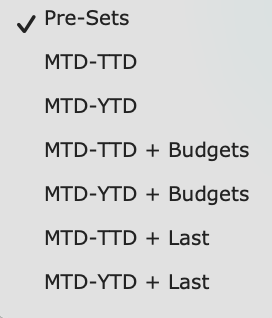
- Presets – The Pre-Sets drop down menu offers six options. Once an option is chosen, SapphireOne will automatically configure the Select menu with the recommended number of columns.
- Select menu – In the Select menu, SapphireOne will present the user with the appropriate number of columns to choose from. The user can utilise the Select menu to pick a column or alternatively, click on the specific column in the column area to make adjustments to the criteria for that particular column.
- Radio Buttons – There is typically no need to adjust the number of columns by selecting a radio button. However, if the user wishes, they can have as many columns as needed for the report, with a maximum limit of 12 columns.
- Column Data – This is the manual alternative to the preset option documented above. Each column must be individually chosen, and the following selections may be made from the drop-down menus:
- Column Year – For the selected column, the user can opt to display data from Last Year through to 8 Years ago.
- Actual Budget – For the selected column, the user has the following data display options: Actual, Budget or Revised Budget.
- Net Balances Checkbox – Select this this checkbox if you wish to include net balances in the printed report.
- Column Header – If necessary, the user can input a custom column heading. To do so, first select the column, then enter the desired heading. Proceed through each column one at a time to input the required headings.
- Saved Reports – When first accessing this function, there might be no saved reports visible. In the list, you will only find the Add… report item. To save a new report, choose the Add… report option. Any previously saved reports will be accessible in the drop-down list for selection.
- Formula & Format Buttons – Clicking the Formula and Format Buttons button trigger a pop up window where you can choose from various criteria to be applied to the column. Both of these items are documented fully later in this article.
- Formula Button – Selecting this button causes sapphire one to display a pop up where a formula can be applied to a column.
- Format Button – Clicking this button triggers a series of pop-up windows where you can choose to up the manner in which positive and negative values are displayed for the currency.
Mode Menu (Export Financials)
The mode menu is the main driving force for these reports. By default this is set as seen Periods.
From Periods and then from All Projects through to the All Project Class items, the only requirement is for the user to make a selection for the period for the report. For this reason only periods are displayed in the column area when these items are selected.
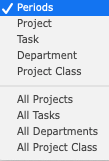
When a Project, Task, Department or Project Class item is selected, the column will be split vertically. The upper part of the column will still display periods, but the lower part will display the item as selected from the mode menu as seen to the right.
The user must then select both the Periods for the report, as well as the Project, Task, Department or Project Class from the lower section of the column.
They have to tell SapphireOne what Period and what Project, Task, Department or Project Class is to be included in the report.
Pre-sets Menu Set as Pre-sets
By default the options screen opens with the Pre-Set menu displaying Pre-sets and a single column. The mouse is then used to select the periods for the columns in the Columns area for the the report. This report may then be immediately printed.
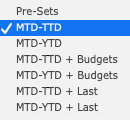
- Columns – Defaults to one column only.
- Pre-sets – SapphireOne opens with this menu item set at Pre-Sets.
- Select – Defaults to General, with Current and Actual as other options
- Mode – This menu is set at Period.
- Period Selection – Defaults to Periods for the column or columns for the report.
- Printing – The user may immediately then print the default report.
There are six additional Pre-sets as depicted in the screenshot above. When any of these are selected SapphireOne will split each column with Periods at the top and the default selection made from the pre-sets menu in the lower part of each column.
- Mode Menu Single Options – By default the initial report is set up on a Period based structure. These mode options are as follows.
- Periods – Default setting for this report editor alter as required.
- Project –Enables reports to be based on a Period or Periods for selected Project or Projects.
- Task – Enables reports to be based on a Period or Periods for selected Task or Tasks.
- Department – Enables reports to be based on a Period or Periods for selected Department or Departments
- Project Class – Enables reports to be based on a Period or Periods for selected Project Class or Project Classes.
- Mode Menu All Options – There are four items at the bottom of the list. All Projects, All Tasks, All Departments and All Project Classes.
- Radio Buttons – The Column Radio buttons are disabled when All is selected and just the single column will be displayed in the upper area.This will allow you set up 1 column and repeat the selection for all of the selected items on the drop-down menu as seen to the right. For example, if you have 100 active projects it will give you income statements with 100 projects in 100 columns.
- Options – The user is given the choice to select whether the report should be purely period-driven or a TTD (Total To Date) report by selecting Periods or TTD from the column itself.
- Format – When this button is selected SapphireOne displays a pop up which allows for the selection of a number of formatting options which is documented later in this section of the manual.
- Net Balances – Select his checkbox if net balances are to be printed.
If the default setup above is not to the users requirements, from here they can make alterations as desired. The basis for the report should be there, with alterations or additions their own custom report can be setup. The documentation above is for the Period mode.
Formula button (Export Financials)
The Formula Button in SapphireOne allows users to apply mathematical operations such as addition, subtraction, and division to various columns in a report. This feature provides users with the flexibility to perform calculations on the data as needed.
Once the formula button is selected sapphire one will display the alert as seen below.
If only one column is selected, the formula alert will display the Summand column with a setting of none. And for those who do not know, a Summand is a mathematical term that refers to an individual term or component that is added to other terms to perform addition. If additional columns are chosen from the main report control screen, they will be listed below the None label. From there, the user can perform various calculations on a column-by-column basis. These operations include Add, Subtract, and Divide.
In the example provided, Column 4 has been configured with the use of the = symbol to calculate a total from: Column 1 + Column 2 + Column 3.
If the user selects the reset button, all calculations will be removed from the formula alert. Once everything is correct, select the “Done” button, and then proceed to export the result from the print dialogue screen.
Format Button (Export Financials)
The Format button serves to configure various currency display options. It’s important to realise that the currency display format for any given report must remain consistent across all columns within that report.
Setting up currency formatting can be a tedious task because the # symbol is used as a placeholder for numbers. If the user does not have a sufficient number of # symbols entered, the values will be truncated. For example, the USD or AUD could use a certain number of # symbols as placeholders, but the Japanese yen would require additional ### symbols to display the same monetary values.
Confirm Alert
When exporting a report with only a single column, this first alert will not be displayed as the currency display settings are being applied to a single column.
However, if the report contains more than one column, the user will receive an initial confirmation alert stating that the currency display settings will be applied uniformly to all columns in the report.
This initial confirmation alert is depicted to the right.
Format Wizard Alert
From this point on wards, the user has several options depending on the selection made from the alert as depicted on the right-hand side.
The user has three choices when setting up the currency display options, which are detailed immediately below.
Format Wizard – This is probably the best option for most users as the user is led through a series of alerts with a pick list provided from each alert screen.
Custom – For this option the user has to manually create the entire layout for the formatting of the currency. They will have to directly enter all of the symbols commas and very other criteria for the currency display.
Standard – This option offers users SapphireOne’s default currency settings, consistent with those available elsewhere in the software. For additional documentation on this, SapphireOne provides a setup procedure within Utilities mode, named FX Currency Settings. that has additional information.
Format Wizard Step 2 Data Entry
On this screen, please choose how you would prefer to display positive and negative numbers.
In the lower section of the screen, under the Example heading, you can preview how both positive and negative numbers will appear in your report.
Once you have completed this task to your satisfaction, click on the Next button to proceed to the next stage in configuring your financial reporting details.
Format Wizard Step 3 Data Entry
On this screen The user is able to select the number of decimal places that appear after the decimal point. The normal setting for this is two decimal places for accountancy.
n the lower section of the screen, under the Example heading, you can preview how both positive and negative numbers will appear in your report.
Once you have completed this task to your satisfaction, click on the Next button to proceed to the next stage in configuring your financial reporting details.
Format Wizard Step 4 Data Entry
In step 4 the user is able to select how zero values are to be displayed in the report.
n the lower section of the screen, under the Example heading, you can preview how both positive and negative numbers will appear in your report.
Once you have completed this task to your satisfaction, click on the Next button to proceed to the next stage in configuring your financial reporting details.
Format Wizard Step 5 Data Entry
At Step 5, users can select both a prefix and, if necessary, a suffix for currency formatting. In the example below, AUD for Australian dollars has been placed as a prefix, and XXX has been placed as a suffix to demonstrate the result of both options.
In the lower section of the screen, under the Example heading, you can preview how both positive and negative numbers will appear in your report.
Once you have completed this task to your satisfaction, click on the Next button to proceed to the next stage in configuring your financial reporting details.
Format Wizard Completion of Data Entry
The last and final step in the process is the finish screen. On this screen, the result of your formatting is displayed first. Please note that the formatting includes all the placeholders used when formatting currency. It’s important to understand that the # symbol is used as a placeholder for currency numbers. If the country’s currency is significantly larger than the dollar, it may be necessary to add at least three more # placeholders to the formatting.
It’s advisable to err on the side of having too many # symbols rather than too few, as excess placeholders will simply go unused. In contrast, if insufficient placeholders are used, the currency may be truncated, limited by the number of # placeholders available.
You can review our Blog and YouTube channel for additional information and resources on SapphireOne ERP, CRM and Business Accounting software.